Contributory members are able to log private notes and comments about each site
Sites Anne T has logged. View this log as a table or view the most recent logs from everyone
Castlesteads (Lowther)
Trip No.68 Entry No.6 Date Added: 10th Apr 2018
Site Type: Misc. Earthwork
Country: England (Cumbria)
Visited: Yes on 5th Apr 2018. My rating: Condition 2 Ambience 4 Access 4
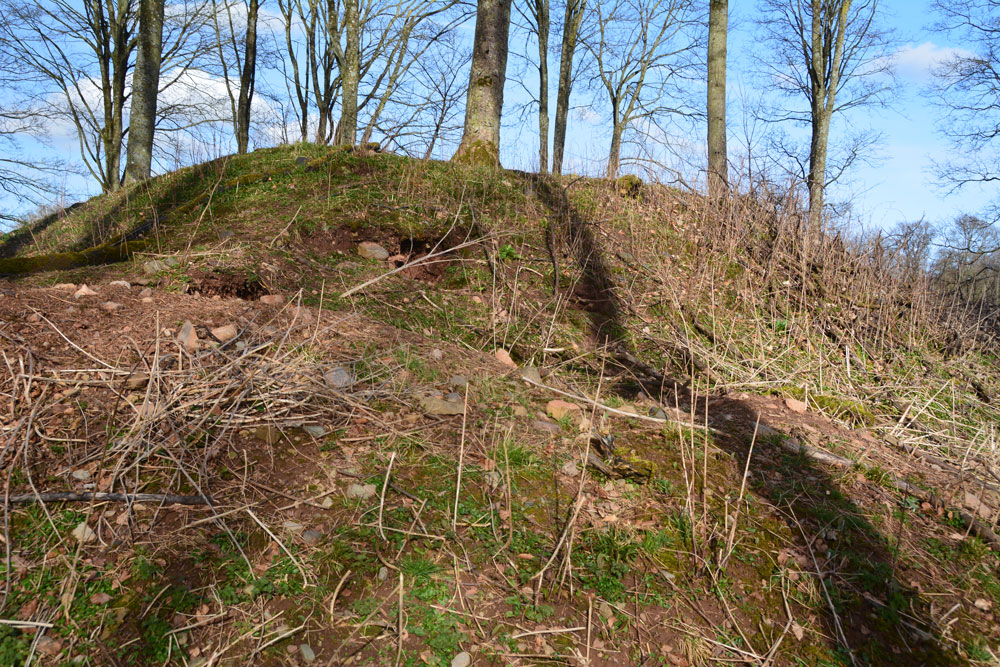
Castlesteads (Lowther) submitted by Anne T on 10th Apr 2018. Approaching the earthworks from its north western side. The bank rises rapidly from the River Lowther below. It's a very strategic spot on a curve of the river.
(View photo, vote or add a comment)
Log Text: Castlesteads Earthworks, Lowther Castle: This Castlesteads (as opposed to the Iron Age settlement we visited next) is just over 220 metres south of the gate into St. Michael’s Churchyard.
Being on a high spot above a bend in the River Lowther, it looks like a very strategic spot to build a defensive structure. In fact, Pastscape says it’s the remains of an old Pele Tower or other medieval building.
Hidden in the woods, but with a footpath leading to it, it is an intriguing ruin, with high banks on all four sides of a rectangle and remnants of the masonry on its western edge.
Towerbrae Cairn
Trip No.69 Entry No.2 Date Added: 5th May 2018
Site Type: Cairn
Country: England (Cumbria)
Visited: Saw from a distance on 23rd Apr 2018. My rating: Condition 2 Ambience 3 Access 4

Towerbrae Cairn submitted by Anne T on 5th May 2018. This very blurry photograph was taken from the road just north of Luke's Cottage. We had planned to walk up to the cairn, but moments later a heavy downpour sent us up to the Bewcastle Cross instead.
(View photo, vote or add a comment)
Log Text: Towerbrae Cairn, Near Bewcastle: We stopped on the road to St. Cuthbert's, Bewcastle to find out how to walk to this cairn, which was basically up a quad bike track just south of Luke's Cottage. As there was nowhere near to park on a grass verge, we decided to go onto try and find Priest's Well at Bewcastle and stop on the way back.
The weather intervened, and a heavy downpour and heavy black clouds stopped us from doing this walk, but we will come back again.
The cairn is highly visible in the landscape. Apparently there is a modern marker on the cairn, and I'd like to complete our trip by returning soon.
Castlehowe Scar Stone Circle
Date Added: 8th Sep 2014
Site Type: Stone Circle
Country: England (Cumbria)
Visited: Yes on 7th Sep 2014. My rating: Condition 3 Ambience 4 Access 5
Castlehowe Scar Stone Circle submitted by baz on 3rd May 2003. Castlehowe Scar Stone Circle (NY587155).
Ten stones form this small stone circle which is now huddled up against a drystone wall, in a field with a locked gate. On the other side of the wall, there appears to be a stone row.
(View photo, vote or add a comment)
Log Text: Castlehowe Scar Stone Circle, near Shap, Cumbria: Having previously stopped at the Thunder Stone 200 metres to the west of Castlehowe Scar Farm, we drove almost 1 kilometre up to this little stone circle. All the land from the Thunder Stone up to Castlehouse Scar Wood on the right hand side of the road is labelled as access land on the Ordnance Survey maps. Immediately before the wood there is a single track metalled road, which turns right towards Hardendale Quarry, with room for 2-3 cars to park on the verge next to the field containing the stone circle.
Whilst the land is labelled access land, there was a padlock on the gate to the field, so we explored from the field next door, where there seemed to be a few red granite stones poking up through the grass in the field. ‘A stone row’, my husband pronounced.
Having driven over 60 miles to get here, and having checked that the field really was access land, in frustration we ended up climbing over the gate to walk quickly round this small stone circle (this is in complete contrast to the farmer at the Gamelands Stone Circle, near Orton, who had very kindly put in a kissing gate to allow entry). There was a water container left close to the stones by the farmer, and I was sorely tempted to try and move this out of the way to avoid it spoiling the photographs, but didn’t dare (and I suspect I would have needed a tractor to attempt it).
All the stones were red Shap granite – we wondered after if they had been polished at some stage in the past to make them shine. The red of the granite certainly stood out amongst the white/grey of the natural limestone bedrock nearby. Checking on the geology of the area when we got home, these red granite stones seem to only came from a very small area, so any of these red stones would have needed to have been quarried and moved up to their current locations.
Strangely, to me, the size of the stones seemed large in comparison to the diameter of the circle, as they did what remained of Kemp Howe at the edge of Shap Village.
Whilst we were parked at Castlehowe Stone Circle, there were many cars coming and going – dog walkers, people doing outdoor activities (we thought they might be cavers) and the owner of the wood next door. Curious that so many people were around, but no-one took any notice of the stone circle, apart from us – perhaps they are all too familiar with it.
We next drove on to Iron Hill, further down the minor road running alongside Castlehouse Scar Wood to Hardendale Quarry to continue our Stone Circle and Cairn adventure.
Gamelands
Date Added: 8th Sep 2014
Site Type: Stone Circle
Country: England (Cumbria)
Visited: Yes on 7th Sep 2014. My rating: Condition 3 Ambience 4 Access 4
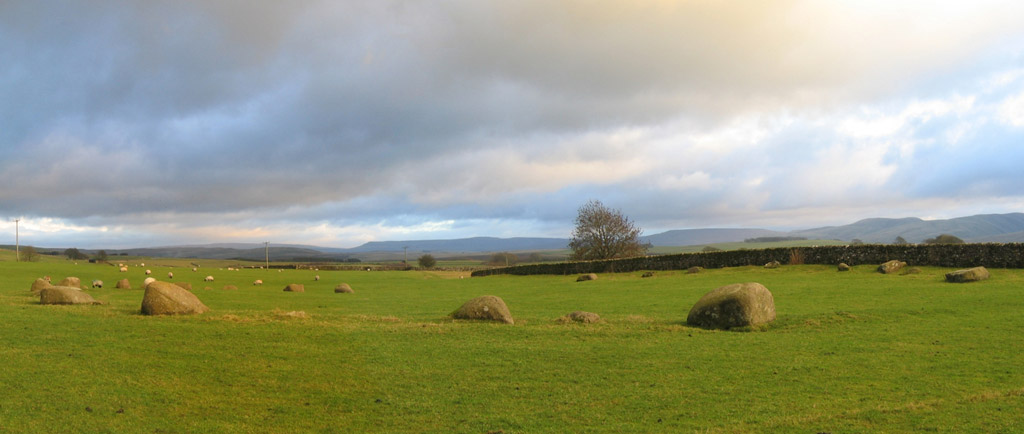
Gamelands submitted by LivingRocks on 8th Feb 2005. Photographed in November 2004 with short grass, a superb site even though the stones are all fallen.
(View photo, vote or add a comment)
Log Text: Gamelands Stone Circle, near Orton, Cumbria: By now, it was late afternoon, with the evening rapidly approaching, and almost time to head off home. From the Oddendale Cairns and Stone Circle we headed off in search of something to eat and drink before finding Gamelands. In Orton, we found the Chocolate Factory still open and busy, so stopped off for very welcome refreshments.
I found navigating to this stone circle tricky, as it’s on the edge of two map sheets, so we took the wrong road out of Orton before identifying the right minor road, signposted to Raisbeck. Following the B6261 past a minor crossroads just out of Orton village (the left hand side being Street Lane), the B road shortly afterwards turns to the right; the minor road needed to get to Gamelands Stone Circle carrying straight on to Knott Lane, signposted as ‘Public Byway leading over Knott Green to Public Bridleway’. Knott Lane is about 1 mile east of Orton. When we visited, there was a large pile of stones, being used to repair the bridleway blocking part of the entrance, but the minor road was wide enough (just) to bump up onto the grass verge and leave the car to walk up Knott Lane.
As we walked up the bridleway, we didn’t see the stone circle until we were almost upon it. The farmer has put in what looks like a relatively new wooden kissing gate to let people access the field, which was refreshingly nice. Thank you, Mr. Farmer! This is one of the largest stone circles we’ve seen in this area; the Visit Cumbria website tells me that this circle is some 100 yards in circumference.
All the stones have fallen, and it must have been impressive when they stood upright. This stone circle (oval) is certainly in a lovely location and very tranquil. It is situated on a plateau immediately below the impressive Knott Scar which rises up to the North, with spectacular views over the Eden Valley and the North Pennines.
I got to see at close hand how the Shap Red Granite is made up – with large ‘tabular’ feldspar crystals glinting out from the whole. My husband has seen this type of granite polished and used in construction projects/buildings, and if our ancestors did polish these stones, then this circle must have been fantastic when it was created.
After spending some time here, just soaking in the atmosphere, we left to go home, with one final stop, at Raise Howe Tumulus, which was on our way home. A glorious afternoon, very well spent.
Thunder Stone (Castlehowe Scar)
Date Added: 9th Sep 2014
Site Type: Natural Stone / Erratic / Other Natural Feature
Country: England (Cumbria)
Visited: Yes on 7th Sep 2014. My rating: Condition 3 Ambience 3 Access 4
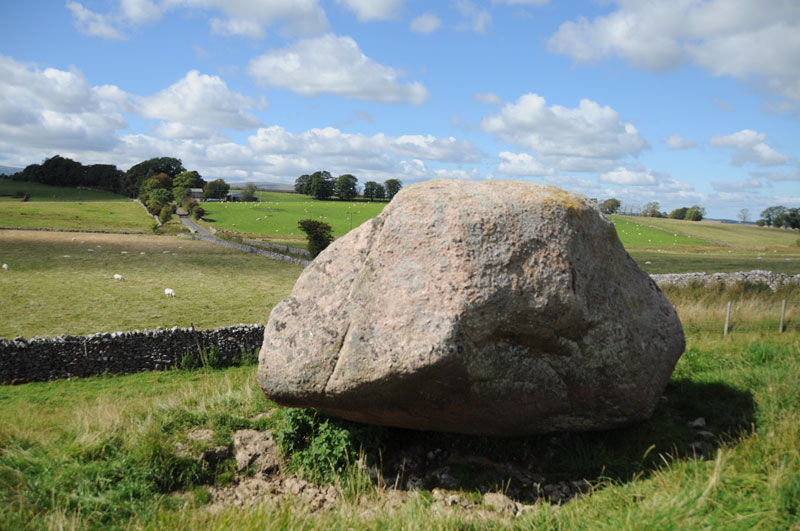
Thunder Stone (Castlehowe Scar) submitted by Anne T on 8th Sep 2014. Another face of this Thunder Stone. The red of the Shap Granite can be clearly seen in the strong sunlight.
(View photo, vote or add a comment)
Log Text: Thunder Stone (Castlehowe Scar), near Shap, Cumbria: When my husband suggested going back to Shap, I groaned inwardly - another day of walking round searching for stones within the village? But I was in for a great surprise. Andrew had identified stone circles and cairns within a few miles of each other, and we had a great afternoon.
On our way to Castlehowe Scar Stone Circle, I spotted two thunder stones marked on the map near Castlehowe Scar Farm on the way to the circle.
From Junction 39, Shap Interchange on the M6, turning right to drive through Shap Village, we took the right hand turn leading to Crosby Ravensworthjust after the Fire Station on the left, and immediately before the chip shop. This road looks as if it is leading into a housing estate, but it does go onto other villages.
Just after passing over the cemetery on the right hand then, then going over the two bridges over the M6 carriageways, I spotted the first of the Thunder Stones, and we stopped on the road for me to take a few photographs. There seem to be so many other erratics in this area, that by the end of the afternoon, I became a little immune to them! This one stood out at the right hand side of the road, perched on the edge of a small quarry. A footpath leading to Hardendale gives access onto the field and it’s possible to go and walk round three sides of the stone (four if you don’t mind heights). It looks as if it is made of Shap granite and in the strong sunlight the red of the Shap Granite stood out beautifully.
[But since the visit, I'm left wondering if this stone is an erratic, as the quarry seemed to be limestone, and the Thunder Stone red Shap granite. Was this stone deliberately brought up the valley to form part of a row to the stone circle? The complexity of the monuments around Shap is quite mind-blowing, especially after our day wandering around some of the gems around Shap.]
Having taken my photographs, we went onto the Castlehowe Scar Stone Circle which is less than one kilometre east of this stone.
Raise Howe Cairn
Date Added: 9th Sep 2014
Site Type: Cairn
Country: England (Cumbria)
Visited: Yes on 7th Sep 2014. My rating: Condition 2 Ambience 3 Access 5
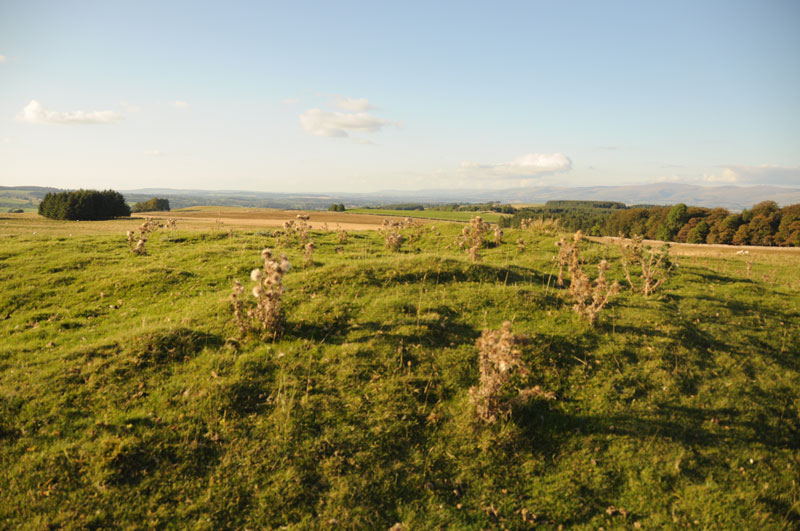
Raise Howe Cairn submitted by Anne T on 9th Sep 2014. Standing on top of Raise Howe Cairn looking north/north-east with Maskriggs Wood at the top right hand side of the picture.
(View photo, vote or add a comment)
Log Text: Raise Howe Cairn, Cumbria: From Gamelands Stone Circle, 1 km east of the village of Orton, we drove back into the village and found the B6260 which heads over the moors towards Crosby Ravensworth and Appleby-in-Westmorland. The road climbs steeply from Orton, leading up onto Orton Scar, Beacon Hill and Gaythorpe Plain. We stopped quickly to see if we could see Gamelands within the context of the landscape, but it seemed to be hidden within a dip beneath Knott Hill in the distance.
The B6260 is a very fast road and once on moorland we needed to be careful of the sheep meandering at the side (and sometimes across) the road. At first glance, you might be forgiven for thinking that Raise Howe Cairn is just a spoil heap next to a quarry, but parking on the verge opposite and walking up to the cairn, its shape and function become apparent. Limestone rubble appears under the soil and turf, and at the top of the mound, there are humps and bumps which make it appear as if the mound has been excavated (although the English Heritage Pastscape records say it has not been).
Our first reaction was “what a spot to be buried in” – there are 360 degree views all around and the landscape as a whole seems too large to take in. The Scale Beck valley lies to the east, the Lyvennet Beck valley to the west and the river Lune in the distance to the south.
Having checked the English Heritage records on my return home, they tell me this is a turf covered, slightly mutilated oval mound of earth and limestone rubble up to 1.2 high, maximum dimensions 23m x 18m and dates from the Bronze Age.
This seems to be a popular picnic spot as there was a lot of rubbish lying around, and a sign next to the quarry says ‘no motor vehicles’ as if someone might drive over the edge of the quarry face.
Not particularly a place to travel to just to see the cairn, but well worth stopping to appreciate the beauty of the landscape and the burial practices of our ancestors.
Kalmott cairn circle
Date Added: 9th Sep 2014
Site Type: Ring Cairn
Country: England (Cumbria)
Visited: Yes on 7th Sep 2014. My rating: Condition 3 Ambience 3 Access 4
Kalmott cairn circle submitted by VapourTrail on 28th Sep 2009. Kalmott cairn on a typically dull Cumbrian day in September.
(View photo, vote or add a comment)
Log Text: Kalmott Cairn Circle, Oddendales, Cumbria: Arriving at Oddendales to see the cairns marked on the OS map, just past the footpath sign pointing us to the Coast-to-Coast/Crosby Ravensworth, we were surprised to come across what appeared to be a small cairn with a ring of stones with a central cluster. It’s not marked on the Ordnance Survey maps.
Sitting between the stone wall of Oddendales Farm on the left and the modern trackway we were walking on, it seemed surprising that this cairn had survived intact. Not been able to find out any more about it, which has been frustrating. I record a photograph here to show what we saw. I’ve now only just found a photograph and brief description about this on Hedge Druid's web site; Hedge Druid says he then submitted it to the Portal for inclusion.
Having taken a couple of photos, we then made our way up to Seal Howe Cairn.
St Mungo's Well (Bromfield)
Trip No.81 Entry No.2 Date Added: 22nd Jul 2018
Site Type: Holy Well or Sacred Spring
Country: England (Cumbria)
Visited: Yes on 9th Jul 2018. My rating: Condition 3 Ambience 4 Access 4
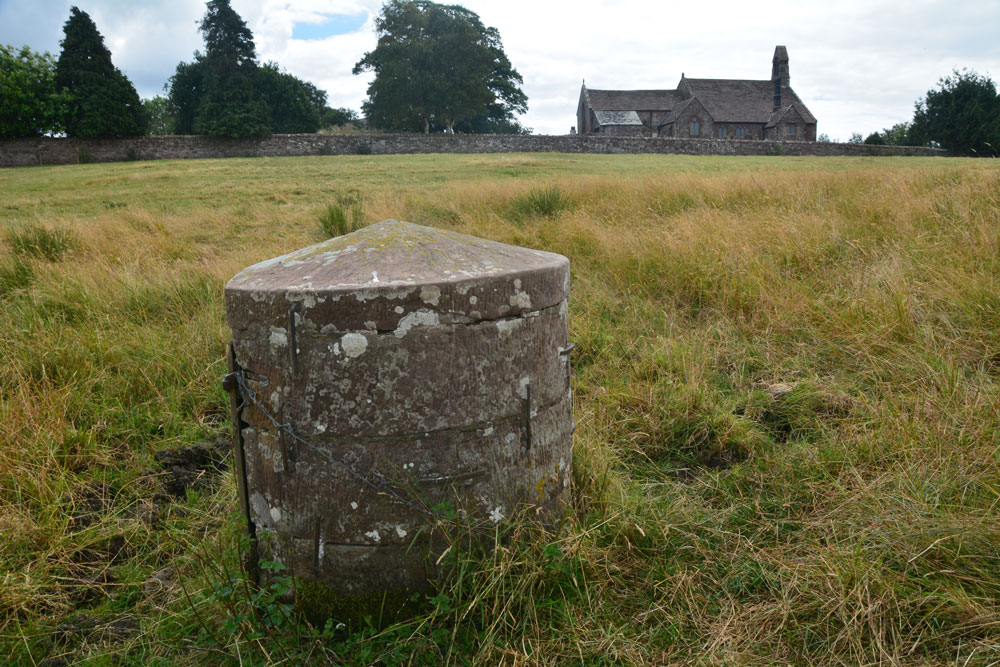
St Mungo's Well (Bromfield) submitted by Anne T on 10th Jul 2018. Standing just to the north of the well, looking back at St Kentigern's Church.
(View photo, vote or add a comment)
Log Text: St Mungo's Holy Well, Bromfield: The kissing gate from the north of the churchyard led down some sandstone gate, although the gate had been wired shut with a cable tie, so we had to clamber over. Even though there had been a long period of dry weather, parts of the ground around the well were still damp and the cattle’s hooves had sunk deep into the ground, creating tussocks and hollows. The well cavity itself was dry. In a very scenic setting, with lazy cattle (and a bull) lazing against a nearby hedgerow, looking over at us, but fortunately too hot to move.
A lovely well in a very nice, tranquil setting.
The Hatching Well (Gilcrux)
Trip No.81 Entry No.3 Date Added: 10th Jul 2018
Site Type: Holy Well or Sacred Spring
Country: England (Cumbria)
Visited: Yes on 9th Jul 2018. My rating: Condition 4 Ambience 3 Access 5
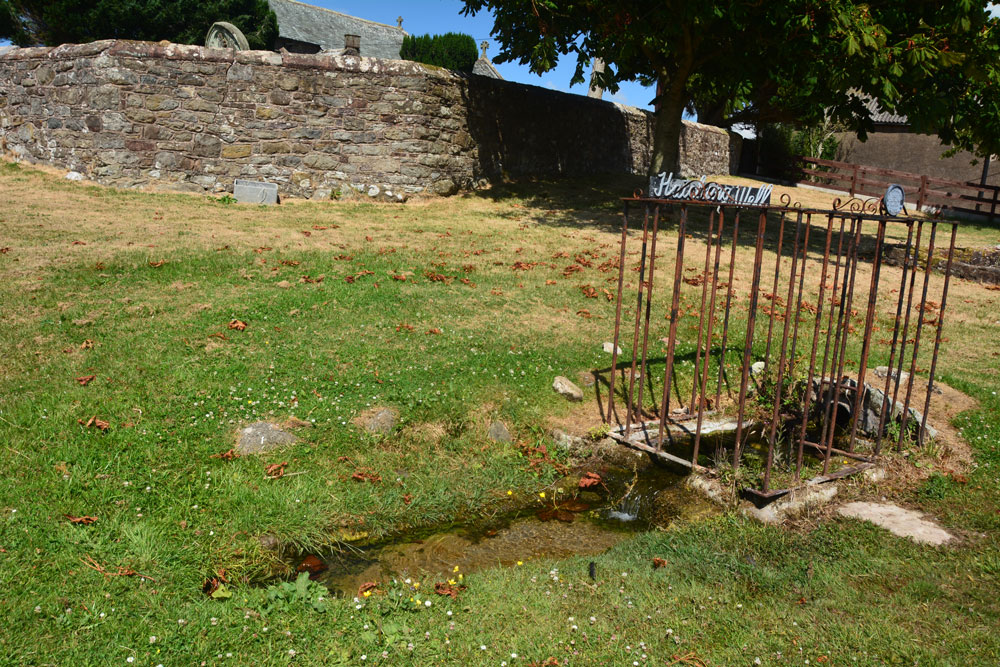
The Hatching Well (Gilcrux) submitted by Anne T on 10th Jul 2018. Standing just to the west of The Hatching Well, looking towards the southern boundary wall of St Mary's churchyard, just behind.
(View photo, vote or add a comment)
Log Text: The Hatching Well, Gilcrux: We arrived here and find this well bubbling away just outside the church - completely unexpected as it's not got any entries on Pastscape or Historic England. Neither is it mentioned in the Wikipedia entry for Gilcrux.
I guess finding this well made up for not being able to get into the church, which was very firmly locked and bolted, despite thinking we'd be able to get in. I'm trying to arrange with the vicar to go back mid-August to see AS Corpus Gilcrux 01.
Seal Howe
Date Added: 9th Sep 2014
Site Type: Cairn
Country: England (Cumbria)
Visited: Yes on 7th Sep 2014. My rating: Condition 3 Ambience 3 Access 4
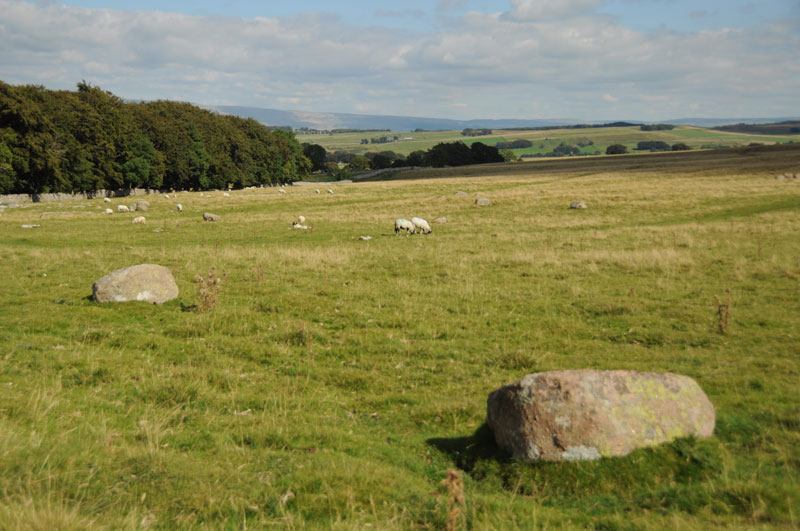
Seal Howe submitted by Anne T on 9th Sep 2014. To the left hand side of the path leading to Seal Howe, we were amazed at the number of red granite rocks lying in the landscape. They stood out clearly from the limestone pavement bedrock.
(View photo, vote or add a comment)
Log Text: Seal Howe Cairn, Oddendale, Cumbria: Having passed Kalmott Cairn Circle by the stone wall next to Oddendale, we made our way to the Bield and Cairn Circle marked on the map.
All around, the limestone pavement/bedrock pushed its way above the grass; it was particularly spectacular on the right hand side of the path. My husband and I were both transfixed and amazed at the number of red Shap Granite stones in the landscape and wished we had a GPS device to map the locations of some of the stones, as there seems to be a much larger prehistoric landscape here. These red granite stones must have been transported up to the site from where they were quarried (which a quick check on the geology of the Lake District indicates just south of Shap).
The modern cairn built on top of Seal Howe wasn’t quite what I was expecting, but the views over to Yorkshire to the east were spectacular. To the north-north-west, the scar of Hardendale Quarry was easily visible.
From Seal Howe, we made our way over the west side of the track to where the map promised us a ‘cairn circle’. This was a treat I wasn’t expecting – the Oddendale Stone Circle.
Oddendale
Date Added: 9th Sep 2014
Site Type: Stone Circle
Country: England (Cumbria)
Visited: Yes on 7th Sep 2014. My rating: Condition 4 Ambience 5 Access 4
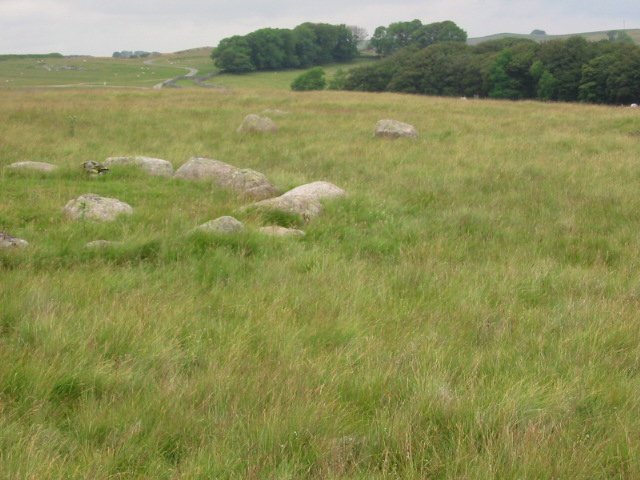
Oddendale submitted by stu on 20th Jul 2002. 592129 NE Lakes Sheet.
Excellent double ringed circle, a must see.
(View photo, vote or add a comment)
Log Text: Oddendales Stone Circle, Oddendale, Cumbria: From Seal Howe, heading directly north west across the pasture to the ‘cairn circle’ was interesting walking, as the ground was lumpy and bumpy with hidden stones underneath. I was not prepared for what we found – a beautiful stone circle of some 34 stones (if I counted correctly) with an inner circle that looked like it had been a cairn or inner mound.
I wish I had a wide-angled lens to capture the beauty of this stone circle in the landscape (if you can successfully ignore the scar of Hardendale Quarry in the background, which we did). Even with my husband perched on top of a nearby stone to get a higher angle, we couldn’t achieve the shot we wanted.
Nearby are also other large red granite stones that we thought might have formed an avenue (but we are quite imaginative people, and would love to have the skills to interpret the prehistoric landscape).
Walking back to the car by the hamlet of Oddendale (according to the Visit Cumbria website, not simply just a farm), the limestone pavement is impressive.
Driving onto Gamelands Stone Circle, it hit me how large the prehistoric landscape is around Shap, and how important an area it must have been in the past.
Iron Hill North
Date Added: 9th Sep 2014
Site Type: Stone Circle
Country: England (Cumbria)
Visited: Yes on 7th Sep 2014. My rating: Condition 3 Ambience 4 Access 4
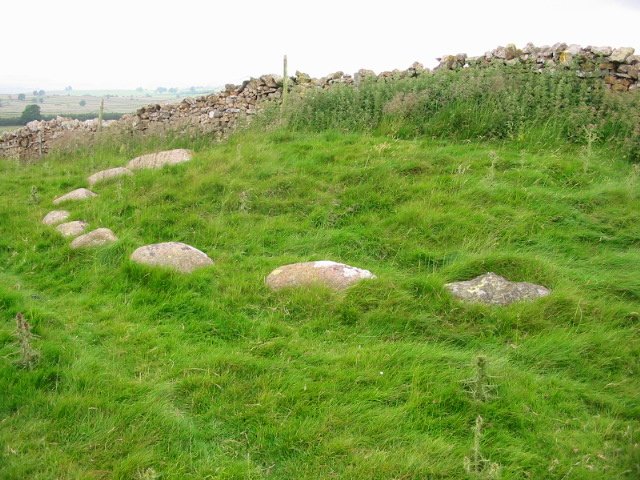
Iron Hill North submitted by stu on 21st Jul 2002. 596147 NE Lakes Sheet.
10 stones remain on one side of a wall.
First stone on right is limestone the rest granite, this is found also at the Gamelands circle, Gunnerkeld and Iron Hill south a few metres away.
(View photo, vote or add a comment)
Log Text: Iron Hill North Cairn/Stone Circle: From Castlehowe Scar Stone Circle, we drove down the single track road towards Hardendale Quarry, with Castlehouse Scar wood on our left hand side. Where the wood ends, the road turns a sharp left and right. Just where the road turns right, there is a marked footpath, walled on both sides, running uphill towards Harberwain Rigg. It is an easy walk despite the path being a little overgrown.
There is a cairn and a cairn circle marked on the Ordnance Survey map. At first all we could see was a limestone scar running to our right, then the first of the stones poked their heads above the grass in front of us, forming a semi-circle around slight mound against a stone wall above us. The stones shone pink in the bright sunlight. If I’m allowed to use the word, this was another ‘cute’ circle and I felt privileged to see it. In the background, the bright water of the lake at the bottom of Hardendale Quarry with its muddy gray ramps and walls contrasted sharply, horribly and incongruously with this wonderful little monument.
Out of interest, we walked a little way up the footpath to where it dissects another running northwards and peered over the gate to see the other side of the circle. I saw one stone peeping (just) above the grass, but couldn’t be sure it was part of the circle.
With a party of walkers making their way down hill towards us, we ventured south to find the other stone circle or cairn at Iron Hill South.
Iron Hill South
Date Added: 9th Sep 2014
Site Type: Stone Circle
Country: England (Cumbria)
Visited: Yes on 7th Sep 2014. My rating: Condition 3 Ambience 4 Access 4
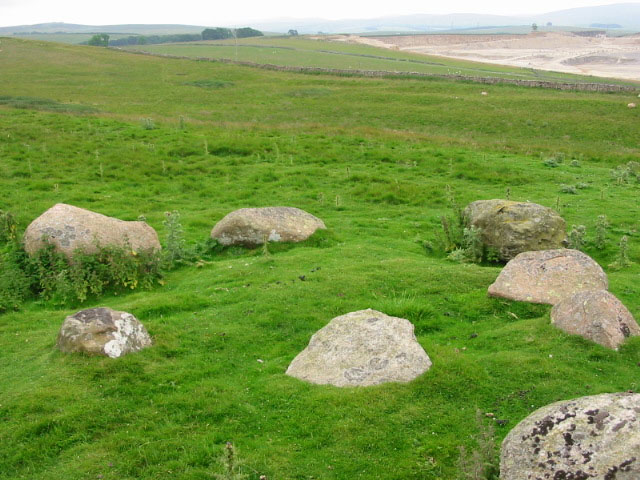
Iron Hill South submitted by stu on 16th Jul 2004. NY596 148.
The small, slightly odd circle of Iron Hill South.
(View photo, vote or add a comment)
Log Text: Iron Hill South Cairn/Stone Circle, near Oddendale, Cumbria: Just 50 metres south of Iron Hill North Cairn/Stone Circle there is another monument, not far from a limestone scar (small modern quarry or crag?). It can be easily seen from Iron Hill North.
Whilst we were looking at this monument, we could hear a party of walkers were coming down the hill towards us. With loud voices, one of the men was proclaiming ‘there’s a stone circle just over here’. Waving his GPS device as he approached us, we were quizzed about which was the cairn and which was the stone circle (both are marked as a cairn and a cairn circle on our OS map), then the walkers left without really taking a look. This amused me greatly, although I wished I had his GPS device.
I couldn’t make up my mind as to whether this was a cairn or another stone circle; instinct said ‘cairn circle’ as there was a grouping of stones in the centre.
After soaking in the atmosphere of this place, we left to go onto Oddendale hamlet, further south along the single track road, and effectively a dead end, to see Seal Howe cairn and the cairn circle nearby.
St Mary's Church (Gilcrux)
Trip No.81 Entry No.4 Date Added: 10th Jul 2018
Site Type: Ancient Cross
Country: England (Cumbria)
Visited: Yes on 9th Jul 2018. My rating: Condition 3 Ambience 4 Access 4

St Mary's Church (Gilcrux) submitted by Anne T on 10th Jul 2018. We may not have been able to see the Viking cross head and shaft fragment, but we did spot this underneath the window in the southern external wall of the sanctuary. The notes inside the church say it is the remains of a grave slab, recut for use as a lintel.
(View photo, vote or add a comment)
Log Text: Viking cross head and shaft fragments, St Mary's Church, Gilcrux: We arrived here to find the outer screen door open, but the door into the church very firmly locked. To say this was disappointing was an understatement, as the building looking fascinating with a lot of history from the outside.
I have since exchanged emails the vicar, who is arranging for the church to be opened for us on either 13th or 14th August.
St Mungo's Dearham
Trip No.91 Entry No.4 Date Added: 16th Aug 2018
Site Type: Ancient Cross
Country: England (Cumbria)
Visited: Yes on 14th Aug 2018. My rating: Condition 3 Ambience 4 Access 5
St Mungo's Dearham submitted by coin on 29th Mar 2017. The Viking Cross at Dearham
(View photo, vote or add a comment)
Log Text: St Mungo's Church, Dearham: AS Corpus Dearham 03 and The Adam Stone: This was a return visit. pre-arranged with the lovely Reverend Mary, who drove from Crosscanonby to very kindly unlock the door of the vestry to show us AS Corpus Dearham 03, part of a cross-head.
We also saw the Adam Stone. Mary moved the knitted figures of Jesus and Peter and invited me to climb on the pew to get a better photograph. We felt so welcome, we didn’t really want to leave!
Chantry Well (Brigham)
Trip No.91 Entry No.6 Date Added: 18th Aug 2018
Site Type: Holy Well or Sacred Spring
Country: England (Cumbria)
Visited: Yes on 14th Aug 2018. My rating: Condition -1 Ambience 2
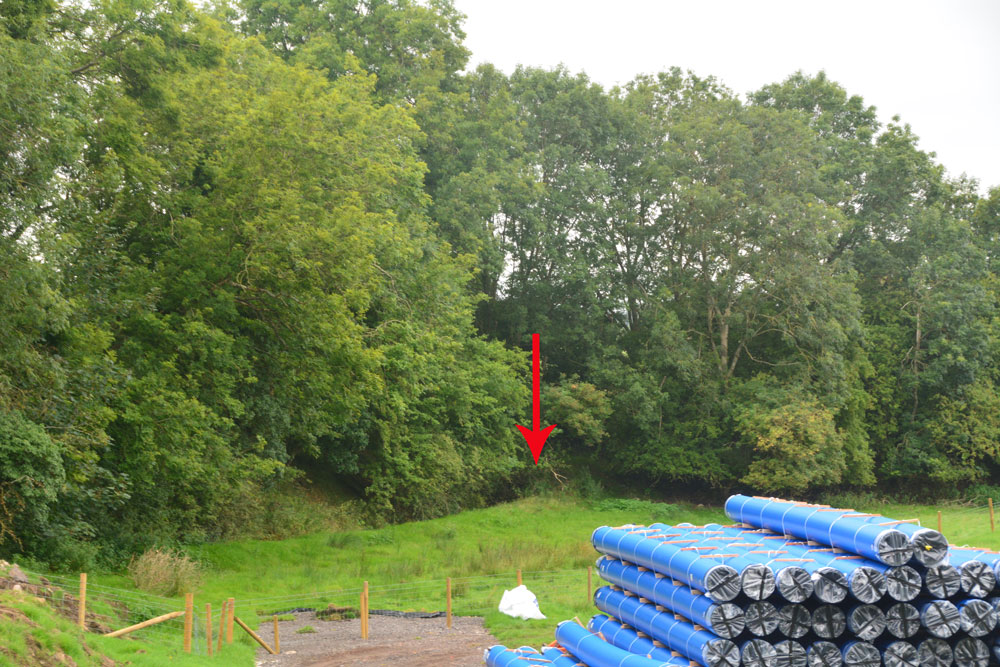
Chantry Well (Brigham) submitted by Anne T on 16th Aug 2018. This is the approximate site of the Chantry Well, as pointed out by the church warden of St. Bridgets, and as recorded by Pastscape Monument 9025 and the Old Cumbria Gazetteer. A new mains water pipeline is being driven through the field, although it was previously recorded the well was destroyed by quarrying. Some marshy ground still remains fenced off in the corner by the red arrow.
(View photo, vote or add a comment)
Log Text: Chantry Well, Brigham (Destroyed) The Reverend Mary told us there was a holy well at Brigham. There are actually 2 listed – Chantry Well and Nun’s Well, next to the A66.
Mr. Furness, the church warden also mentioned the well, but said it was no longer there. In the field opposite the church, a new water pipeline is being constructed. In the field to the south a new housing estate is also being built. There is no access into the field because of the building works, but the grid reference gives a point where the tree line bends.
Bewcastle Cross
Date Added: 11th Oct 2015
Site Type: Ancient Cross
Country: England (Cumbria)
Visited: Yes on 11th Oct 2014. My rating: Condition 3 Access 5
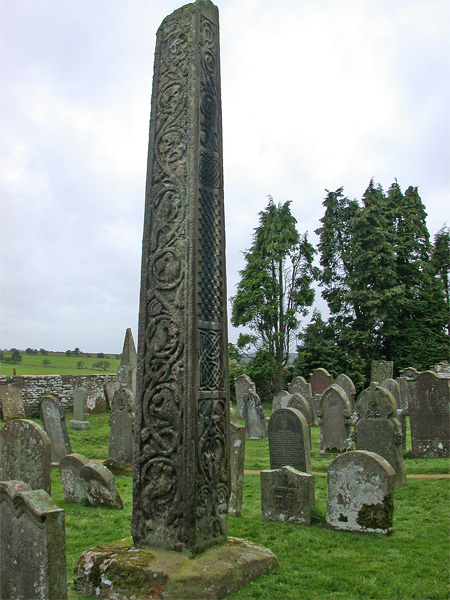
Bewcastle Cross submitted by nicoladidsbury on 20th Sep 2004. Bewcastle Cross, Cumbria
Image shows the detail from the north and east sides of the 15m cross. These sides are very well preserved.
The north side is divided into five compartments. In the highest and lowest are vines running in graceful curves and bearing foliage and fruit. "In the second and fourth divisions are two curiously-devised and intricately-twisted knots." The third division is filled with the chequer work. Between the compartments are lines of Runes which are now so indi...
(View photo, vote or add a comment)
Log Text: Bewcastle Cross. Fourth visit, 22nd August 2015. We first came here back in 1992/1993 not long after we'd moved to Dumfries. Funny, as from dim and distant memory both my husband and I remembered this (falsely) as being the Ruthwell Cross. After having taken a photo of our 3 children gathered round the foot of the cross in the mist and drizzle, for the last couple of years I'd wanted to recreate this photograph, so for my **th birthday, the family (complete with next generation) gathered. The skies were still murky and grey although the cross doesn't appear to have changed one bit.
After taking a photo of the children as they are now, we gathered to whole family, complete with next generation, taking photos with the remote shutter control.
The museum display has improved a lot since our visit in 2014, and I came prepared with printed sheets from the Anglo Saxon Corpus but didn't find any of the Saxon grave covers in their inventory, although there was one on display, very simply carved, which was labelled as being from the 8th to 11th century.
11th October 2014: Third visit. We last came here on 15th August 2013, but I was really quite ill (a bug, not a hangover!) and had to find a quiet corner of the churchyard, so I don’t remember very much of the visit to the church. I do remember walking around the castle with the farmer and his wife gardening nearby so I felt like a trespasser.
Today, as we reached St. Cuthbert’s church, the sun came out and highlighted the cross and many of the carvings showed clearly, especially the worn and weathered runes on the eastern face.
The exhibition has been improved since our visit, with displays about the runes and their meanings and a new painting of what the cross might have looked like when it was first erected.
There were less fragments in the exhibition outbuilding than I remembered.
Waberthwaite Cross
Date Added: 27th Oct 2014
Site Type: Ancient Cross
Country: England (Cumbria)
Visited: Yes on 24th Oct 2014. My rating: Condition 3 Ambience 4 Access 5
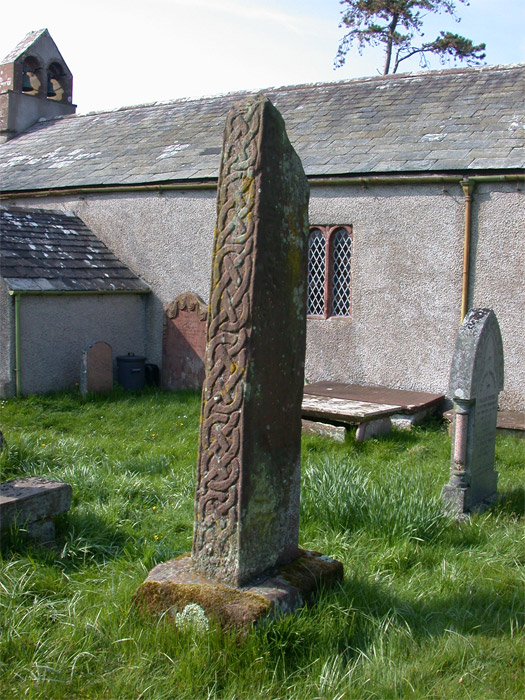
Waberthwaite Cross submitted by nicoladidsbury on 27th Apr 2005. Ancient Anglian/Scandinavian Stone Cross at St John's Church, Waberthwaite.
South and East sides, showing the crisp unweathered carving on the south side.
The Cross Shaft is 2m high, and quite badly weathered, making it difficult to see the carvings on the main panels, however the edges (north and south sides) are still remarkedly clear.
The cross is thought to date from the 9th to 10th centuary, and shows influences of anglican and viking carving styles.
(View photo, vote or add a comment)
Log Text: Ancient crosses, St John the Baptist Church, Waberthwaite: This was our last planned stop of the day and dusk was drawing in. I confess to being a little tired of getting in and out of the car by this time, but a drive down a narrow country lane to reach a cluster of farm houses by the estuary of the River Esk was worth it. Outside the church of St John the Baptist looks derelict and unloved, with the door being guarded by a simple wire frame held shut by a wire closure.
Finding ‘Waberthwaite 02’ cross shaft and basewas easy, as it sat immediately to the east of a tall sundial. ‘Waberthwaite 01’ was a bit more of a challenge until I realised it had been laid flat on the plinth of the sundial (verified by the notes inside the church).
Simple manipulation of the wire frame in the church porch allowed entry, and the door to the church had been left unlocked - inside it is small but cosy, like stepping back into the 18th century. There are box pews put in by the Victorians and the bells are rung from the outside.
Notes in the church read: “The churchyard contains a sandstone sundial, possibly 18th century. Its height is explained by the fact that it was designed to be read by someone on horseback. Behind it is the shaft of an ancient preaching cross. For many years this was part of the lintel of the church porch. The cross head has been lost. It is very worn, but the carving includes interlaced foliage and, on the east face, pictures of a horse and two figures facing one another. Lying on the base of the sundial is another broken cross shaft rescued from the threshold of the porch in the 1800s. Again the cross head is lost. For many years the larger cross was thought to be 9th century or later, but recent archaeological discoveries put it earlier, in the 8th century. This makes the Waberthwaite Cross one of the earliest in West Cumbria. The existence of the crosses is evidence of a very early Christian settlement on this site.”
It wasn’t difficult to imagine early Christians stopping off at the site to worship by the cross.
Irton Cross
Date Added: 27th Oct 2014
Site Type: Ancient Cross
Country: England (Cumbria)
Visited: Yes on 24th Oct 2014. My rating: Condition 4 Ambience 4 Access 5
Irton Cross submitted by Thorgrim on 27th Mar 2004. In the churchyard at Irton is the ancient Irton Cross, which stands 10 feet high and was erected in the early 9th Century, before the Viking invasions. Pevsner declares that this is one of the most important crosses in Cumbria, and unlike the one at Gosforth, bears no figures either human or animal. It contains vine scrolls and rosettes of Irish origin.
(View photo, vote or add a comment)
Log Text: Ancient cross shaft, head and base, St Paul’s, Irto, Cumbria: This cross, apart from the Gosforth Cross, is perhaps the most complete of all those we saw during our day in this part of Cumbria. From the Ordnance Survey map, we weren’t sure if we could drive most of the way, or if we needed to walk some distance along a footpath, but with a school and a church marked in close proximity, we decided to drive as far as we could. From Gosforth, we drove down the A595 through Holmrook, then took a left hand turn onto a minor road, past Gubbergill. A left hand turn is signposted towards ‘church’ and we drove down a single lane road past what had been a school, then through the narrow stone gates to the church, where after a couple of hundred yards, the lane widens out into a reasonably large car park. As we came closer to the church, there were surprisingly spectacular views over Lake District, which loomed impressively gray and large in the near distance.
St. Paul’s church is surprisingly large for its remote location, and obviously well used.
We found this complete cross shaft, head and base in the churchyard south of the church rising high above us. Dating from the first half of the 9th century, the head is edged by fine double roll mouldings. I was fascinated by the head of the cross, which on its west face has a cabled circle enclosing five pellets arranged in a cruciform pattern.
The cross shaft, head and base are referenced as Irton 01. The ASCorpus notes told me that Irton 02, a 10th century cross head, is actually at Muncaster in the churchyard of St. Michael’s and All Angels, cemented onto a plinth in front of Muncaster 01.
St Bee's Priory Crosses
Date Added: 27th Oct 2014
Site Type: Ancient Cross
Country: England (Cumbria)
Visited: Yes on 24th Oct 2014. My rating: Condition 3 Ambience 3 Access 5
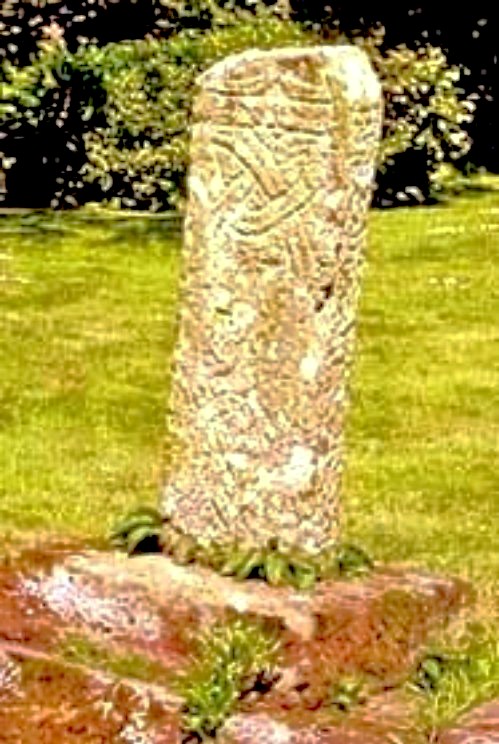
St Bee's Priory Crosses submitted by Sunny100 on 11th Jun 2010. 9th century cross-shaft in St Bees Priory graveyard, Cumbria, at NX.969122
(View photo, vote or add a comment)
Log Text: Ancient Crosses, St. Bees Priory (notes: 1. all the leaflets and books refer to this as ‘St Bees Priory Church’ but the name, according to information plates in the church is ‘St Mary and St. Bega. 2. I record this visit as 'ordinary' as the church was having its complete heating system replaced and was like a building site. Once this is complete, it will be 'good').
This was our first stop on an 'ancient cross hunt' day. Following the A595 from Whitehaven, we turned towards the sea down Mirehouse Road towards St. Bees. We drove past the church at first, as it looked too modern from the road, but on closer inspection, it really is old! Sited near the station, there is car parking for 4-5 cars at the south east corner of the church, with a level pathway to follow to the west door.
Entering the churchyard, we saw St Bees 01, the 10th century cross shaft, in the middle of the churchyard by a large, round bush. The ASCorpus notes say it also has part of the cross head at the top of the shaft, although this wasn’t immediately obvious, although I can now see this in the photographs. According to the little leaflet I bought from the church, this cross stands in the graveyard to symbolise all those who are buried here, rather than there being individual grave markers. This then gives a different meaning to the other similar crosses we saw in other churches, being described as preaching crosses. I wonder who is right? In a history of St. Bees (see source below) this cross is described as being ‘Hiberno-Norse’; ASCorpus dates it to the 10th century.
Many of the grave stones have been cleared away, making the grass easier to cut, and there is a drop between the edge of the churchyard and the church itself, with plenty of bright yellow ‘danger’ notices. Near the lych gate, there is a sundial which dates to 1649, although the top has been broken off.
Having travelled over 90 miles to get here, we arrived at the west door to find a notice to say the church was closed Mondays to Thursdays as they were having the heating pipes replaced. As it was a Friday and someone else had just come out we went in; we were stopped by one of the plumberswho said the church was closed, and I said we’d driven a long way to come here, he said ‘be careful’. The church was covered in plastic lining and plumbing pieces everywhere, including dustpans and brushes placed in the ‘history area’ at the south east end of the church.
This visit was slightly disappointing, as we didn’t find St Bees 06, part of a round shaft or pillar which was supposed to be at the east end of the south aisle of the church, inside. We explored all the other areas, including the ‘new history area’ and poked my head into the rooms being used by the heating engineers, but nothing. Three other pieces (St Bees 03, 04 and 05) were buried under the south aisle of the church, so couldn’t be seen, and St. Bees 07 was in someone else’s possession. St Bees 08 is difficult to find, being placed in the south west arch way, almost buried by ferns. I had to compare it to the photograph on the ASCorpus records very carefully to make sure I’d understood what I’d seen.
Outside the fascinating west door, underneath this same archway, there was another sandstone cross sited underneath an arch. It’s not described in the church guide, but in a frame in the church, it is described as “a cross which stood at the breast of the hill on the main road to Whitehaven. It is variously thought to be a ‘sanctuary cross’, marking the boundary of the parish, or a resting cross on a coffin road. The ‘coffin roads’ date from medieval times when many West Cumbrian parishes did not have the licence to bury, and bodies were brought to St. Bees. These crosses served as symbolic resting places on route.” The archway lintel comprises a “pre-Conquest carved Beowulf Stone, on a lintel between the Church and the Vicarage, showing St Michael killing a dragon.”
